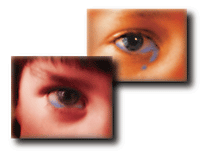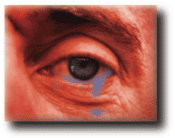 Continued...
Crying
sometimes emerges from an understanding that a situation calls
for the expression of something unsayable. Unsayables do not occur
randomly in social life. Social stratification shapes their distribution.
People at elite levels in organizations are often limited in what
they can say because, in a kind of bureaucratic noblesse oblige,
as part of their work they must be diplomatically indulgent in
their public relations work with ignorant outsiders.
Continued...
Crying
sometimes emerges from an understanding that a situation calls
for the expression of something unsayable. Unsayables do not occur
randomly in social life. Social stratification shapes their distribution.
People at elite levels in organizations are often limited in what
they can say because, in a kind of bureaucratic noblesse oblige,
as part of their work they must be diplomatically indulgent in
their public relations work with ignorant outsiders.
 For
converse stratification reasons, pariah people often cannot speak
things they understand because their status in society entails
an everyday suffering of indignities in silence. Elias Canetti
provided the unforgettably bitter (fictional) example of tears
filling the eyes of a "blind" beggar who had to suffer the humiliation
of publicly thanking people who had thrown buttons instead of
money into his hat.
For
converse stratification reasons, pariah people often cannot speak
things they understand because their status in society entails
an everyday suffering of indignities in silence. Elias Canetti
provided the unforgettably bitter (fictional) example of tears
filling the eyes of a "blind" beggar who had to suffer the humiliation
of publicly thanking people who had thrown buttons instead of
money into his hat.
In
the vividly real setting of Unity Church in Los Angeles, pariah
people--parishioners in drag, AIDS sufferers, recovering addicts--are
regularly moved to tears as they rise to take the microphone to
tell the church of their problems. As services start, church leaders
parade to the stage, carried forward by a rhythmic hymn that the
entire assemblage creates through song and movement. Then the
microphone is given to members of the audience, who rise and are
immediately moved to the brink of an inability to continue speaking.
One parishioner struggles against tears and, through a whispered
voice, asks communal prayers for her upcoming lung operation.
A young man shakes with emotion as he delivers a political speech
criticizing homosexuals for failing to support their public action
organizations more vigorously. A woman cry-talks the story of
her recent and still tentative recovery from years of disgraceful
neglect of her children while she supported a cocaine habit through
prostitution. As speakers rise to cry-talk, their emotions are
inspired by the understanding that the church community pushes
them, as multiply pariah people, to dare to say publicly what
they are elsewhere encouraged to deny.
Consider
the familiar scenes of crying by people receiving awards, being
honored at retirement parties, or being interviewed because of
their celebrity or notoriety. Technological developments have
given unprecedented force to the challenges that are faced by
people who are placed at the center of collective attentions and
are then asked to make personal responses in public recognition
of their glorious or inglorious achievements. Even in a two-person,
face-to-face interview situation, a rolling camera encourages
an interviewee to anticipate an infinitely large and eternally
observing audience. Whether rising before the academy to accept
an award that recognizes one's superlative contributions to a
professional community, or responding to questions on one's bloody
criminal career, the person who breaks down in tears is likely
to break down at much the same narrative points. Crying emerges
where he or she attempts to utter words that bridge relationships
between an infinitely large communal audience and intimate regions
of private life.
 Movies
and television have enormously increased the frequency of events
in which people struggle to make themselves a live, immediately
observable, visible bridge between the largest and the smallest
social worlds that they inhabit. The juxtaposition of the solitary
figure addressing an infinite audience--a classic and early example
of which was the isolation of Lou Gehrig as a tiny figure addressing
a packed Yankee Stadium at a day honoring him on the occasion
of his disease-occasioned retirement--once required extraordinary
organizing efforts to create. Now an analogous interaction environment
can be created for a speaker by the introduction of a video camera
at the most casual retirement party.
Movies
and television have enormously increased the frequency of events
in which people struggle to make themselves a live, immediately
observable, visible bridge between the largest and the smallest
social worlds that they inhabit. The juxtaposition of the solitary
figure addressing an infinite audience--a classic and early example
of which was the isolation of Lou Gehrig as a tiny figure addressing
a packed Yankee Stadium at a day honoring him on the occasion
of his disease-occasioned retirement--once required extraordinary
organizing efforts to create. Now an analogous interaction environment
can be created for a speaker by the introduction of a video camera
at the most casual retirement party.
It
is, however, rare to catch a glimpse of the inverse crying situation:
occasions in which people privately cry as they sense the public
ramifications of something that is quietly transpiring. A creative
arrangement of one such moment was described by Christopher Buckley,
as he recounted the mechanics of dedicating a book he authored:
"I was finishing The White House Mess just as I was about
to be married. I asked Lucy to put a sheet of paper in the typewriter,
and I said, 'Now, type, "For my wife, with love."' And she cried."
Presumably the immediate emotional force would have been somewhat
blunted had Buckley asked, "What do you think of this as a dedication
for my book?" providing Lucy with an occasion to speak her sense
of relating their private and public identities in this manner.
Instead
Buckley invokes a multilayered, interaction-triggered, and deeply
implicit irony to give the moment explosive force. He uses an
ending, of the book writing, to mark a beginning, of their public
identity as a couple. She is honored, by being asked to perform
a menial clerical task. He makes her a partner in his professional
life. And he instantly summons a larger audience to their wedding
than any caterer could conceivably handle. As Lucy performs the
task, the two become married before either gets to say "I do,"
at least in the sense that the dedication commits them to an eternal
public revelation of their commitment to each other, making a
record that, compared to the legal force of the papers they will
soon sign, is eternally irreversible.





![]()
 Continued...
Crying
sometimes emerges from an understanding that a situation calls
for the expression of something unsayable. Unsayables do not occur
randomly in social life. Social stratification shapes their distribution.
People at elite levels in organizations are often limited in what
they can say because, in a kind of bureaucratic noblesse oblige,
as part of their work they must be diplomatically indulgent in
their public relations work with ignorant outsiders.
Continued...
Crying
sometimes emerges from an understanding that a situation calls
for the expression of something unsayable. Unsayables do not occur
randomly in social life. Social stratification shapes their distribution.
People at elite levels in organizations are often limited in what
they can say because, in a kind of bureaucratic noblesse oblige,
as part of their work they must be diplomatically indulgent in
their public relations work with ignorant outsiders. For
converse stratification reasons, pariah people often cannot speak
things they understand because their status in society entails
an everyday suffering of indignities in silence. Elias Canetti
provided the unforgettably bitter (fictional) example of tears
filling the eyes of a "blind" beggar who had to suffer the humiliation
of publicly thanking people who had thrown buttons instead of
money into his hat.
For
converse stratification reasons, pariah people often cannot speak
things they understand because their status in society entails
an everyday suffering of indignities in silence. Elias Canetti
provided the unforgettably bitter (fictional) example of tears
filling the eyes of a "blind" beggar who had to suffer the humiliation
of publicly thanking people who had thrown buttons instead of
money into his hat. Movies
and television have enormously increased the frequency of events
in which people struggle to make themselves a live, immediately
observable, visible bridge between the largest and the smallest
social worlds that they inhabit. The juxtaposition of the solitary
figure addressing an infinite audience--a classic and early example
of which was the isolation of Lou Gehrig as a tiny figure addressing
a packed Yankee Stadium at a day honoring him on the occasion
of his disease-occasioned retirement--once required extraordinary
organizing efforts to create. Now an analogous interaction environment
can be created for a speaker by the introduction of a video camera
at the most casual retirement party.
Movies
and television have enormously increased the frequency of events
in which people struggle to make themselves a live, immediately
observable, visible bridge between the largest and the smallest
social worlds that they inhabit. The juxtaposition of the solitary
figure addressing an infinite audience--a classic and early example
of which was the isolation of Lou Gehrig as a tiny figure addressing
a packed Yankee Stadium at a day honoring him on the occasion
of his disease-occasioned retirement--once required extraordinary
organizing efforts to create. Now an analogous interaction environment
can be created for a speaker by the introduction of a video camera
at the most casual retirement party.